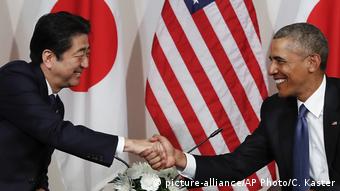Japanese Prime Minister Shinzo Abe and US President Barack Obama visit Pearl Harbor memorial
- Albanian Shqip
- Amharic አማርኛ
- Arabic العربية
- Bengali বাংলা
- Bosnian B/H/S
- Bulgarian Български
- Chinese 中文
- Croatian Hrvatski
- Dari دری
- English English
- French Français
- German Deutsch
- Greek Ελληνικά
- Hausa Hausa
- Hindi हिन्दी
- Indonesian Bahasa Indonesia
AMERICAS
Japanese Prime Minister Shinzo Abe and US President Barack Obama visit Pearl Harbor memorial
Obama and Abe together laid a wreath during a symbolic visit to Pearl Harbor on Tuesday afternoon. The Japanese leader offered condolonces while Obama warned against "the urge to demonize" others.
Japanese Prime Minister Shinzo Abe offered his "sincere and everlasting condolences" to the US service members who died when Japanese planes bombed Pearl Harbor on December 7, 1941.
"We must never repeat the horrors of war again. This is the solemn vow that we, the people of Japan, have taken," Abe said on Tuesday, marking the 75th anniversary of the infamous bombing that launched the US into World War II.
US President Obama, who will leave office in January, said ties between the two nations have "never been stronger."
"The character of nations is tested in war, but it is defined in peace," Obama said in comments that appeared to reference America's current political situation.
"Even when hatred burns hottest, even when the tug of tribalism is at its most primal, we must resist the urge to turn inward. We must resist the urge to demonize those who are different," Obama said.
Earlier, the two leaders took part in a brief wreath-laying ceremony at the USS Arizona Memorial, followed by a moment of silence.
Historic visit
Abe is the first Japanese Prime Minister to visit the USS Arizona Memorial, built over the sunken remains of a ship bombed by Japanese planes in a surprise attack during World War II.
On the morning of December 7, 1941, Japanese torpedo planes, bombers and fighter planes attacked ships moored at the Hawaii base, killing 2,400 people and dragging a reluctant US into the war. The US later dropped two atomic bombs on Japanese cities killing more than 100,000 people.
Abe and Obama met to discuss ties between the two countries and to celebrate "the power of reconciliation." It will likely be Obama's last presidential meeting with a foreign leader, his aides said.

The two met to cement relations between their countries ahead of Donald Trump's January inauguration
Since the war the two countries became close allies in a partnership that strengthened during Obama's leadership.
The two leaders were major backers of the Trans-Pacific Partnership, a major free trade deal that Obama championed and that Abe prioritized in his economic strategy. The deal is now on hold afterremarks by US president-elect Donald Trump during his campaign that clouded US-Japanese relations.
Trump also appeared towaver on US security guarantees that shielded Japan against an increasingly confident China, unless they paid more or acquired nuclear weapons.
In November Abe was the first foreign leader to meet with Trump following his election victory, labeling him a "trustworthy leader."
No apologies on both sides
The Pearl Harbor meeting acted as a bookend for Obama, who in 2009 invited former Japanese Prime Minister Taro Aso as the first foreign leader he hosted at the White House.
The memorial visit came six months after Obama became the first sitting US president to visit Hiroshima, the site of one of the nuclear attacks on Japan.
"This visit, and the president's visit to Hiroshima earlier this year, would not have been possible eight years ago," said Daniel Kritenbrink, Obama's top Asia adviser in the White House.
"That we are here today is the result of years of efforts at all levels of our government and societies, which has allowed us to jointly and directly deal with even the most sensitive aspects of our shared history."
Just as Obama did not apologize for the nuclear attacks, Abe did not apologize for the Pearl Harbor attack.
No Japanese prime minister had visited the USS Arizona Memorial, but in 1951, six years after surrendering former Japanese leader Shigeru Yoshida visited Pearl Harbor.
Other Japanese prime ministers had visited Pearl Harbor and the National Memorial Cemetery of the Pacific, known as Punchbowl.
rs, aw/kl (AP, AFP, dpa, Reuters)






Comments